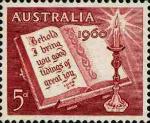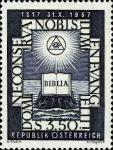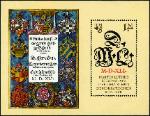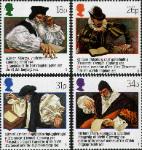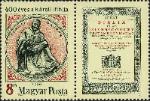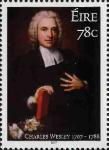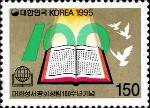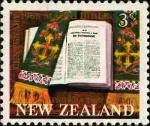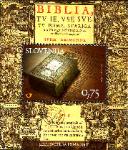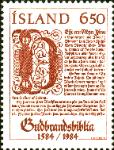| 10a--The Holy Bible (printed) and Missals |
The 350th anniversary of the publication of the King James translation of the Bible was
commemorated by this 5-pence Christmas stamp depicting an open Bible—“Behold, I bring you
good tidings of great joy”—next to a candle (Australia, Scott #339).
commemorated by this 5-pence Christmas stamp depicting an open Bible—“Behold, I bring you
good tidings of great joy”—next to a candle (Australia, Scott #339).
Prior to 31 October 1517, Martin Luther had preached against the indulgence trade within the
Roman Catholic Church. After reading an instruction manual for indulgence traders, he wrote a
letter to his church superiors hoping to get rid of this abuse. In his letter Luther listed 95
theses that were to be used as the basis for a discussion of the topic. His good friend, Philip
Melanchthon, later contended that Luther actually nailed his 95 theses to the door of the
Castle Church in Wittenberg, although that contention has been disputed. But even if Luther’s
hammer strokes only echoed metaphorically throughout Europe, his act became a symbol of the
Reformation as nothing else has. This stamp commemorates the 450th anniversary of the start
of the Reformation; it depicts the Frankfurt Medal for Reformation, issued in 1717, which
features an open Bible (Austria, Scott #801).
Roman Catholic Church. After reading an instruction manual for indulgence traders, he wrote a
letter to his church superiors hoping to get rid of this abuse. In his letter Luther listed 95
theses that were to be used as the basis for a discussion of the topic. His good friend, Philip
Melanchthon, later contended that Luther actually nailed his 95 theses to the door of the
Castle Church in Wittenberg, although that contention has been disputed. But even if Luther’s
hammer strokes only echoed metaphorically throughout Europe, his act became a symbol of the
Reformation as nothing else has. This stamp commemorates the 450th anniversary of the start
of the Reformation; it depicts the Frankfurt Medal for Reformation, issued in 1717, which
features an open Bible (Austria, Scott #801).
The year 1977 marked the 25th anniversary of the reign of Queen Elizabeth II, who was
presented with a copy of the Holy Bible during a visit that year to the British Virgin Islands. The
30-cent value in a set of three stamps issued on 7 February 1977 to mark the Queen’s visit
depicts the presentation Bible (British Virgin Islands, Scott #317).
presented with a copy of the Holy Bible during a visit that year to the British Virgin Islands. The
30-cent value in a set of three stamps issued on 7 February 1977 to mark the Queen’s visit
depicts the presentation Bible (British Virgin Islands, Scott #317).
The first edition of the New Testament translated into Finnish by Michael Agricola was
published in 1548; this stamp marks the 400th anniversary of Agricola’s translation. The 12-
markka value depicts Agricola at work on his translation, which helped fulfill a principle of the
Reformation that anyone should be able to read the Bible in his native language. Agricola’s New
Testament was printed in Stockholm by Amund Laurentsson in an edition of approximately 500
copies; 120 copies are extant today. The typography of the book follows German patterns,
including the 83 different woodcut illustrations, which originated from German printing houses.
Most of them are copies of the pictures made for Martin Luther's Bible translations in the
studio of Lucas Cranach the Elder (Finland, Scott #277).
published in 1548; this stamp marks the 400th anniversary of Agricola’s translation. The 12-
markka value depicts Agricola at work on his translation, which helped fulfill a principle of the
Reformation that anyone should be able to read the Bible in his native language. Agricola’s New
Testament was printed in Stockholm by Amund Laurentsson in an edition of approximately 500
copies; 120 copies are extant today. The typography of the book follows German patterns,
including the 83 different woodcut illustrations, which originated from German printing houses.
Most of them are copies of the pictures made for Martin Luther's Bible translations in the
studio of Lucas Cranach the Elder (Finland, Scott #277).
On 25 September 1972, while the United Bible Societies were holding their World Assembly in
Addis Ababa, Ethiopia, the host country issued a set of three stamps to commemorate the
occasion. The 80-cent value depicts the First Amharic Bible, the language of Ethiopia.
Christianity had entered Ethiopia in the 4th century, and the Bible was translated into Geez
(Ethiopic) soon thereafter. This Bible was revised in the 14th century. I wasn’t until 1840,
however, that the first complete Amharic Bible was published; it went through several revised
editions. The new version of the Bible shown on the stamp was created at the request of
Emperor Haile Selassie; it was first published in 1962 (Ethiopia, Scott #636).
Addis Ababa, Ethiopia, the host country issued a set of three stamps to commemorate the
occasion. The 80-cent value depicts the First Amharic Bible, the language of Ethiopia.
Christianity had entered Ethiopia in the 4th century, and the Bible was translated into Geez
(Ethiopic) soon thereafter. This Bible was revised in the 14th century. I wasn’t until 1840,
however, that the first complete Amharic Bible was published; it went through several revised
editions. The new version of the Bible shown on the stamp was created at the request of
Emperor Haile Selassie; it was first published in 1962 (Ethiopia, Scott #636).
This souvenir sheet was issued on 18 October 1983 to commemorate Martin Luther’s 1541
translation of the Bible; the margin shows the title page, but the surrounding woodcut is not
actually the title-page woodcut by Lucas Cranach the Younger that is found on copies of this
book. Although acquainted with earlier German versions of the Bible, Martin Luther prepared
his new German version of the New Testament of 1522 on the basis of the Greek text of
Erasmus. This effort was followed in 1534 by a German rendition of the Old Testament on the
basis of the Hebrew text, prepared by Luther and several associates in Wittenberg, including
Philip Melanchthon and Johannes Bugenhagen. Translated into a fresh and homely high
German, this Bible helped shape both Lutheran piety and the German language for centuries
to come. Luther's prefaces to the Old and New Testaments, as well as his introductions to
the books of the Bible, provided basic theological and devotional reading for Lutherans as long
as his Bible remained in common use (German Democratic Republic, Scott #2378).
translation of the Bible; the margin shows the title page, but the surrounding woodcut is not
actually the title-page woodcut by Lucas Cranach the Younger that is found on copies of this
book. Although acquainted with earlier German versions of the Bible, Martin Luther prepared
his new German version of the New Testament of 1522 on the basis of the Greek text of
Erasmus. This effort was followed in 1534 by a German rendition of the Old Testament on the
basis of the Hebrew text, prepared by Luther and several associates in Wittenberg, including
Philip Melanchthon and Johannes Bugenhagen. Translated into a fresh and homely high
German, this Bible helped shape both Lutheran piety and the German language for centuries
to come. Luther's prefaces to the Old and New Testaments, as well as his introductions to
the books of the Bible, provided basic theological and devotional reading for Lutherans as long
as his Bible remained in common use (German Democratic Republic, Scott #2378).
The 400th anniversary of the publication of the Welsh Bible of 1588 was commemorated by a
set of four stamps on 1 March 1988 (above); four people involved with its production were
honored. Parts of the Bible had been translated into Welsh before the 15th century, but the
first complete translation was the manuscript of Celydd Sfan, a translation from the Latin
Vulgate. While no exact date for its composition is known, it was in existence by 1470.
Following the English Reformation, translations were made from Greek versions. The New
Testament translation of William Salesbury (Scott # 1206) was printed in 1567 by Humphrey
Toy, closely followed by William Morgan’s (Scott #1205) translation of the whole Bible in 1588.
Morgan soon began work on a revision (or a new translation) of his 1588 Bible, which contained
a number of printing errors. After Morgan's death, Bishop Richard Parry (Scott # 1208) and Dr.
John Davies (Scott #1207) continued the work with the aim of improving the literary language,
replacing forms considered too colloquial, and bringing the text into greater conformity with the
Authorized Version of the English Bible of 1611. The revised version of the Bible was published
in 1620. (Great Britain, Scott #1205-1208).
set of four stamps on 1 March 1988 (above); four people involved with its production were
honored. Parts of the Bible had been translated into Welsh before the 15th century, but the
first complete translation was the manuscript of Celydd Sfan, a translation from the Latin
Vulgate. While no exact date for its composition is known, it was in existence by 1470.
Following the English Reformation, translations were made from Greek versions. The New
Testament translation of William Salesbury (Scott # 1206) was printed in 1567 by Humphrey
Toy, closely followed by William Morgan’s (Scott #1205) translation of the whole Bible in 1588.
Morgan soon began work on a revision (or a new translation) of his 1588 Bible, which contained
a number of printing errors. After Morgan's death, Bishop Richard Parry (Scott # 1208) and Dr.
John Davies (Scott #1207) continued the work with the aim of improving the literary language,
replacing forms considered too colloquial, and bringing the text into greater conformity with the
Authorized Version of the English Bible of 1611. The revised version of the Bible was published
in 1620. (Great Britain, Scott #1205-1208).
The Bible in Iceland, one of the northern parts of the Danish realm, was translated into the
local language after the Protestant Reformation. The first complete edition of the Bible in
Icelandic was published by Bishop Gudbrandur Thorlaksson (1542-1627) in 1584. King Frederik
II (1534-1588) financed the publication and ordered that a copy of the new Bible should be
found in every church in Iceland. Gudbrandur Thorlaksson also did some of the translation
himself. One thousand copies of the Bible were printed at his printing office at the Episcopal
residence of Hólar. The 400th anniversary of Gudbrand’s Bible was commemorated by a two-
value set issued on 29 November 1984. (Iceland, Scott #597).
local language after the Protestant Reformation. The first complete edition of the Bible in
Icelandic was published by Bishop Gudbrandur Thorlaksson (1542-1627) in 1584. King Frederik
II (1534-1588) financed the publication and ordered that a copy of the new Bible should be
found in every church in Iceland. Gudbrandur Thorlaksson also did some of the translation
himself. One thousand copies of the Bible were printed at his printing office at the Episcopal
residence of Hólar. The 400th anniversary of Gudbrand’s Bible was commemorated by a two-
value set issued on 29 November 1984. (Iceland, Scott #597).
Hungary issued this 8-forint stamp on 24 April 1990 to honor the 400th anniversary of the
Karoli Bible. The translator, Gáspár Károli (1529-1591), was the pastor of Göncz in Upper
Hungary. The stamp is printed se-tenant with a label picturing the Bible’s frontispiece
(Hungary, Scott #3240).
Karoli Bible. The translator, Gáspár Károli (1529-1591), was the pastor of Göncz in Upper
Hungary. The stamp is printed se-tenant with a label picturing the Bible’s frontispiece
(Hungary, Scott #3240).
Last Updated on 26 August 2009
This stamp is one of several to commemorate the 300th birth anniversary of Charles Wesley
(1707-1788), who, with his brother John, were instrumental in the birth of the Methodist religious
tradition. Their teachings and practices earned the name “Methodist” because of their strict
adherence to the Book of Common Prayer, which Charles is shown holding in this stamp’s
illustration. Charles Wesley is also remembered for his achievements in lyrical composition. Over
the course of his lifetime, he published the words of more than 5,500 hymns, and composed the
words for 2,000 more. Among these are a number of timeless classics, including Hark! The Herald-
Angels Sing (Ireland, Scott #1763).
(1707-1788), who, with his brother John, were instrumental in the birth of the Methodist religious
tradition. Their teachings and practices earned the name “Methodist” because of their strict
adherence to the Book of Common Prayer, which Charles is shown holding in this stamp’s
illustration. Charles Wesley is also remembered for his achievements in lyrical composition. Over
the course of his lifetime, he published the words of more than 5,500 hymns, and composed the
words for 2,000 more. Among these are a number of timeless classics, including Hark! The Herald-
Angels Sing (Ireland, Scott #1763).
Work on the biblical translation commemorated by this stamp (above) began in 1988.
Postponed twice at the request of the Icelandic Bible Society, the stamp appeared in October
2007, the year a new original translation of the Bible into Icelandic appeared. Methods of
biblical translation had changed greatly in the previous two decades, and new approaches had
been developed in translation theory. Knowledge of ancient texts and their cultural
backgrounds had also increased vastly during the previous century. The first Icelandic New
Testament had been published in 1540; the entire Bible appeared in print in 1584. Since then
the Bible had been published an additional 10 times in the Icelandic language. Five of these
publications were new translations. The letters of the word “Biblía” are embossed on the
stamp with 22 carat gold, each representing the typeface used in the six Icelandic Bible
translations, five earlier ones and the October 2007 version. The years of publication for each
edition appear below each letter (Iceland, Scott #1118).
Postponed twice at the request of the Icelandic Bible Society, the stamp appeared in October
2007, the year a new original translation of the Bible into Icelandic appeared. Methods of
biblical translation had changed greatly in the previous two decades, and new approaches had
been developed in translation theory. Knowledge of ancient texts and their cultural
backgrounds had also increased vastly during the previous century. The first Icelandic New
Testament had been published in 1540; the entire Bible appeared in print in 1584. Since then
the Bible had been published an additional 10 times in the Icelandic language. Five of these
publications were new translations. The letters of the word “Biblía” are embossed on the
stamp with 22 carat gold, each representing the typeface used in the six Icelandic Bible
translations, five earlier ones and the October 2007 version. The years of publication for each
edition appear below each letter (Iceland, Scott #1118).
The Christmas issue of 1975 for the Isle of Man was a set of four stamps that also
commemorated the bicentenary of the Manx Bible, whose title page is pictured on the 5½ pence
value. Manx, a Celtic language spoken on the Isle of Man, is closely related to the Gaelic
dialects of Ulster and Galloway. The first Manx Bible was printed between 1771 and 1775 and is
the source and standard for modern Manx orthography. It was a collective translation
undertaken by most of the Manx clergy under the editorship of Philip Moore. Further editions
followed in 1777 and 1819 (Isle of Man, Scott #74).
commemorated the bicentenary of the Manx Bible, whose title page is pictured on the 5½ pence
value. Manx, a Celtic language spoken on the Isle of Man, is closely related to the Gaelic
dialects of Ulster and Galloway. The first Manx Bible was printed between 1771 and 1775 and is
the source and standard for modern Manx orthography. It was a collective translation
undertaken by most of the Manx clergy under the editorship of Philip Moore. Further editions
followed in 1777 and 1819 (Isle of Man, Scott #74).
| Please CLICK on an image for an ENLARGED version. |
Hebrew manuscripts of the scriptures were relatively common in the Renaissance and,
because of religious obligation among scribes, had always been copied with extraordinary care
and far greater fidelity to their exemplars than the equivalent Christian books in Latin.
Printing in Hebrew began about 1470, and the complete Hebrew Bible, based upon the Ben
Asher text, was printed for the first time in 1488 in the town of Soncino, between Milan and
Mantua. The printer was Joshua Solomon Soncino, a member of a family of German Jews
surnamed Soncino from the town where they first printed. This stamp commemorates the
500th anniversary of the Soncino Bible (Italy, Scott #1733).
because of religious obligation among scribes, had always been copied with extraordinary care
and far greater fidelity to their exemplars than the equivalent Christian books in Latin.
Printing in Hebrew began about 1470, and the complete Hebrew Bible, based upon the Ben
Asher text, was printed for the first time in 1488 in the town of Soncino, between Milan and
Mantua. The printer was Joshua Solomon Soncino, a member of a family of German Jews
surnamed Soncino from the town where they first printed. This stamp commemorates the
500th anniversary of the Soncino Bible (Italy, Scott #1733).
South Korea marked the centennial of the Korean Bible Society with this 150-won stamp on 18
October 1995. It depicts an open Bible (South Korea Scott #1830).
October 1995. It depicts an open Bible (South Korea Scott #1830).
The centennial of the Maori Bible issued on 23 April 1968 is commemorated by this stamp
from New Zealand. The Bible was translated into the Maori language by missionaries
sponsored by the Church Missionary Society. The first Maori New Testament was published in
1837 and the first edition of the full Maori Bible was published in 1868, which is
commemorated by this stamp. Since then, there have been four revisions of the full Bible at
intervals of 21 years, 36 years and finally 27 years up to the 1952 edition. The New Zealand
Bible Society has a vision for a new translation of the Bible into modern colloquial Maori (New
Zealand Scott #408).
from New Zealand. The Bible was translated into the Maori language by missionaries
sponsored by the Church Missionary Society. The first Maori New Testament was published in
1837 and the first edition of the full Maori Bible was published in 1868, which is
commemorated by this stamp. Since then, there have been four revisions of the full Bible at
intervals of 21 years, 36 years and finally 27 years up to the 1952 edition. The New Zealand
Bible Society has a vision for a new translation of the Bible into modern colloquial Maori (New
Zealand Scott #408).
The Bounty Bible, one of two books of Scripture brought onto the island in 1790 from HMS
Bounty, is today kept in a special case in the island’s Seventh-day Adventist church
(Pitcairn Islands Scott #5A).
Bounty, is today kept in a special case in the island’s Seventh-day Adventist church
(Pitcairn Islands Scott #5A).
The Reformation in Europe saw the translation from Latin into vernacular languages and
subsequent publication of many religious works, including the Bible. In Slovenia, Primož Trubar
(1508-1586), a priest and disciple of Martin Luther and now revered as the father of written
Slovenian, wrote the first books in the Slovenian language and in 1582 completed the
translation of the New Testament. In 1584, Jurij Dalmatin published 1,500 copies (50 on
special paper) of his complete translation of the Bible with 222 woodcuts copied from the work
of Lucas Cranach, fifty years after Martin Luther’s German edition. In his foreword, Dalmatin
acknowledged his debt to Trubar. Dalmatin's Bible established Slovenian as a mature literary
language and served for 200 years as a model for later biblical translations and other literature.
About 80 copies worldwide are extant today, seven at the National and University Library of
Ljubljana. This 0.75€-value stamp shows the Dalmatian Bible lying on an enlarged page of the
general foreword. The miniature sheet is decorated with Cranach illustrations, including the
one that contains the publication date of 1584. The stamp was featured at the World Congress
of the International Organization for the Study of the Old Testament (IOSOT) held in Ljubljana
in July 2007. Designed by Matjaz Ucakar. Printed offset by Oriental Press, Bahrain (Slovenia,
Scott #724).
subsequent publication of many religious works, including the Bible. In Slovenia, Primož Trubar
(1508-1586), a priest and disciple of Martin Luther and now revered as the father of written
Slovenian, wrote the first books in the Slovenian language and in 1582 completed the
translation of the New Testament. In 1584, Jurij Dalmatin published 1,500 copies (50 on
special paper) of his complete translation of the Bible with 222 woodcuts copied from the work
of Lucas Cranach, fifty years after Martin Luther’s German edition. In his foreword, Dalmatin
acknowledged his debt to Trubar. Dalmatin's Bible established Slovenian as a mature literary
language and served for 200 years as a model for later biblical translations and other literature.
About 80 copies worldwide are extant today, seven at the National and University Library of
Ljubljana. This 0.75€-value stamp shows the Dalmatian Bible lying on an enlarged page of the
general foreword. The miniature sheet is decorated with Cranach illustrations, including the
one that contains the publication date of 1584. The stamp was featured at the World Congress
of the International Organization for the Study of the Old Testament (IOSOT) held in Ljubljana
in July 2007. Designed by Matjaz Ucakar. Printed offset by Oriental Press, Bahrain (Slovenia,
Scott #724).
